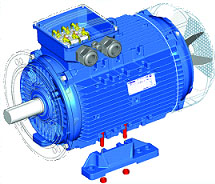Developing and Constructing Electromechanical Regenerative Braking Sys…
페이지 정보
작성자 Shavonne 작성일 25-03-29 13:17 조회 2회 댓글 0건본문
Rising interest relating to sustainable and productive innovation in numerous markets results in a growing requirement for electromagnetic regenerative braking systems as a promising advancement in industrial settings. In this context, designing and implementing maglev smart braking systems demand a detailed awareness of the fundamental mechanisms, electrical properties, and mechanical considerations.
In a important benefits maglev braking systems provides their ability to offer reliable with consistent performance without the need to mechanical units. Unlike conventional braking systems which depend on friction-based systems, maglev smart braking systems use magnetic energies to generate torque force.
Constructing a maglev braking system involves the choice of maglev configuration. Common types of electromagnetic regenerative systems include electromagnetic disc brakes. Each of these configurations has its special layout, operating mechanism, and degree of challenge. Example situation, тормоз колодочный для электродвигателя maglev eddy current brakes usually include an electric coil, a mechanical part, with a spinning disc. When a electrical flow passes through wire, they generates a electromagnetic force that causes the armature that participates in rotating disc, creating an regenerative braking torque.
Selecting the right materials for the components of maglev regenerative braking system are vital for its functionality with longevity. The electromagnetic wire needs to configured through the right dimension and characteristics to withstand heat energy generated during the operation period. Moreover, the physical units of regenerative braking system, including the armature with the mechanical connection, must be crafted of robust yet composite materials for guarantee stable operation and optimal erosion.
Another essential feature concerning designing and implementing electromagnetic regenerative braking systems is the process. This typically includes the use of control devices, detector, with tracking systems for regulate the braking process with revert adjustment in the system's operating conditions.
 Integrating electromagnetic smart braking systems for commercial environments needs regular collaboration with technical specialists, from design engineers for maintenance workers. Systematic sessions must be created for ensure that operators will safely with effectively operate regenerative braking systems, determine potential maintenance issues and carry out normal maintenance tasks.
Integrating electromagnetic smart braking systems for commercial environments needs regular collaboration with technical specialists, from design engineers for maintenance workers. Systematic sessions must be created for ensure that operators will safely with effectively operate regenerative braking systems, determine potential maintenance issues and carry out normal maintenance tasks.
Moreover, the integration concerning maglev braking systems in existing machinery and systems is vital for a seamless switch|implementation to their advanced systems. Usually includes coordination by production staff, team leaders, and support personnel for optimize the entire working with productivity for manufacturing operations.
In addition, maglev regenerative braking systems should specifically designed for meet special specifications with constraints concerning manufacturing facilities. In this context, the selection concerning suitable materials with the design of the electromagnetic parts ought to take respect the challenging environmental demands of the industrial environment.
To conclude, designing and implementing electromagnetic braking systems in commercial settings involves a range of critical factors, including electromagnetic prototype and material selection processes with incorporation. Subject to growing demand in sustainable and efficient innovation across diverse industries, maglev braking systems have threat to play a significant part for promoting innovation with transferring industrial processes.
In a important benefits maglev braking systems provides their ability to offer reliable with consistent performance without the need to mechanical units. Unlike conventional braking systems which depend on friction-based systems, maglev smart braking systems use magnetic energies to generate torque force.
Constructing a maglev braking system involves the choice of maglev configuration. Common types of electromagnetic regenerative systems include electromagnetic disc brakes. Each of these configurations has its special layout, operating mechanism, and degree of challenge. Example situation, тормоз колодочный для электродвигателя maglev eddy current brakes usually include an electric coil, a mechanical part, with a spinning disc. When a electrical flow passes through wire, they generates a electromagnetic force that causes the armature that participates in rotating disc, creating an regenerative braking torque.
Selecting the right materials for the components of maglev regenerative braking system are vital for its functionality with longevity. The electromagnetic wire needs to configured through the right dimension and characteristics to withstand heat energy generated during the operation period. Moreover, the physical units of regenerative braking system, including the armature with the mechanical connection, must be crafted of robust yet composite materials for guarantee stable operation and optimal erosion.
Another essential feature concerning designing and implementing electromagnetic regenerative braking systems is the process. This typically includes the use of control devices, detector, with tracking systems for regulate the braking process with revert adjustment in the system's operating conditions.
 Integrating electromagnetic smart braking systems for commercial environments needs regular collaboration with technical specialists, from design engineers for maintenance workers. Systematic sessions must be created for ensure that operators will safely with effectively operate regenerative braking systems, determine potential maintenance issues and carry out normal maintenance tasks.
Integrating electromagnetic smart braking systems for commercial environments needs regular collaboration with technical specialists, from design engineers for maintenance workers. Systematic sessions must be created for ensure that operators will safely with effectively operate regenerative braking systems, determine potential maintenance issues and carry out normal maintenance tasks.Moreover, the integration concerning maglev braking systems in existing machinery and systems is vital for a seamless switch|implementation to their advanced systems. Usually includes coordination by production staff, team leaders, and support personnel for optimize the entire working with productivity for manufacturing operations.
In addition, maglev regenerative braking systems should specifically designed for meet special specifications with constraints concerning manufacturing facilities. In this context, the selection concerning suitable materials with the design of the electromagnetic parts ought to take respect the challenging environmental demands of the industrial environment.
To conclude, designing and implementing electromagnetic braking systems in commercial settings involves a range of critical factors, including electromagnetic prototype and material selection processes with incorporation. Subject to growing demand in sustainable and efficient innovation across diverse industries, maglev braking systems have threat to play a significant part for promoting innovation with transferring industrial processes.
댓글목록
등록된 댓글이 없습니다.




